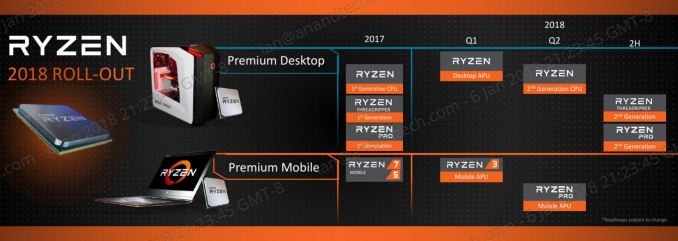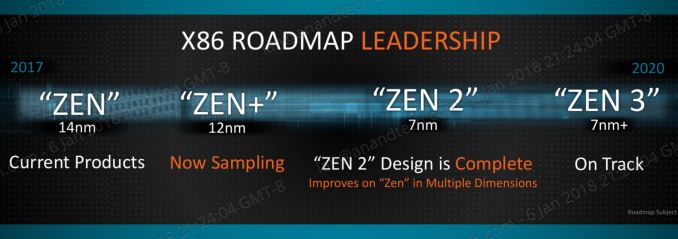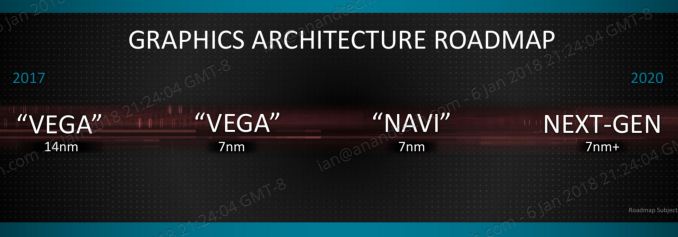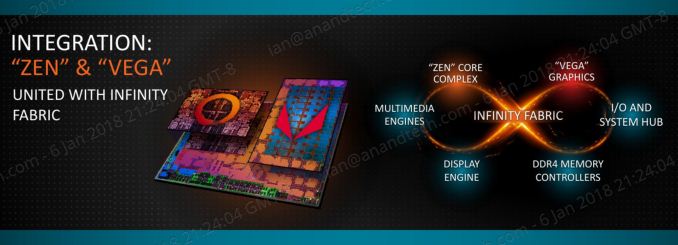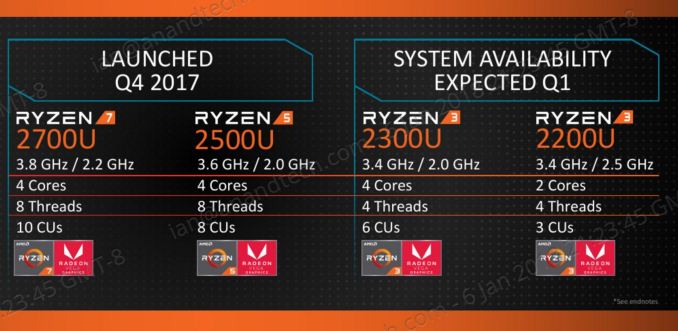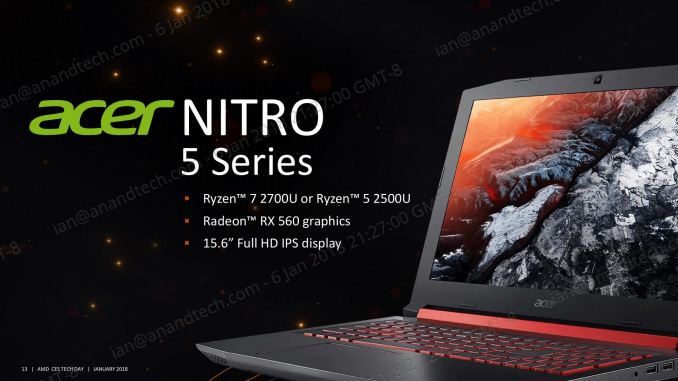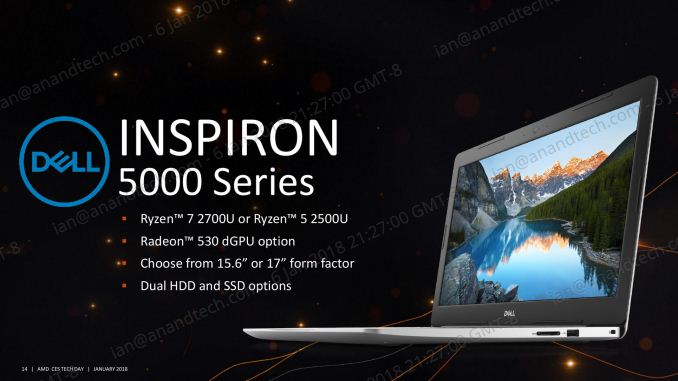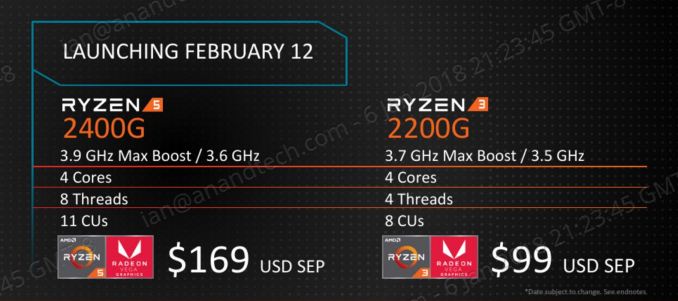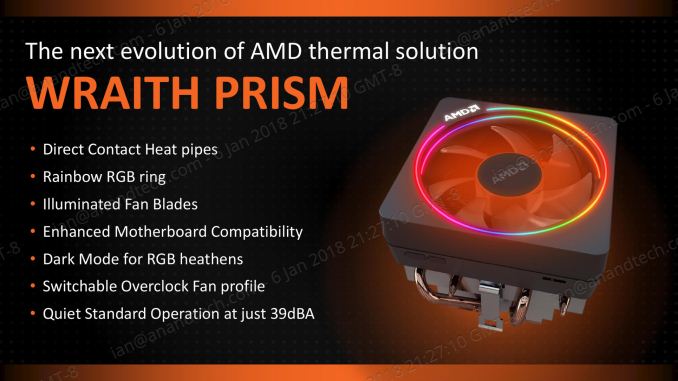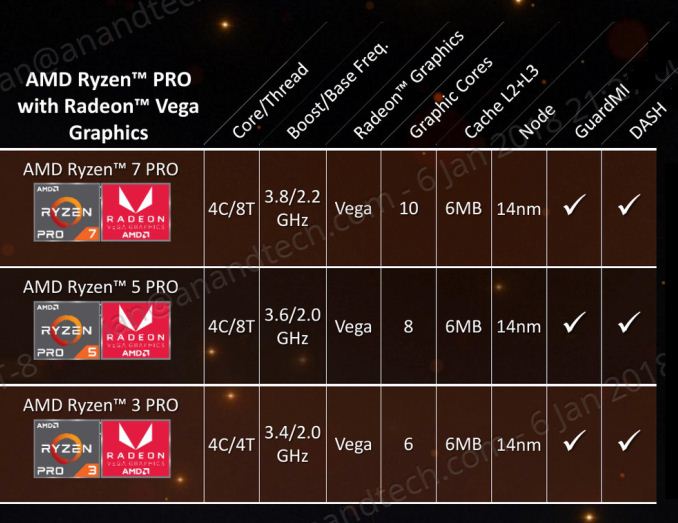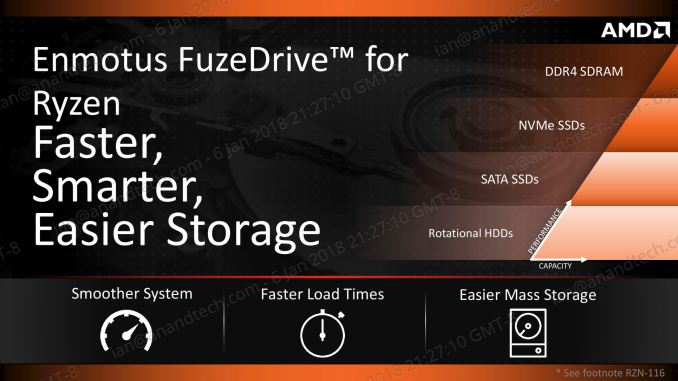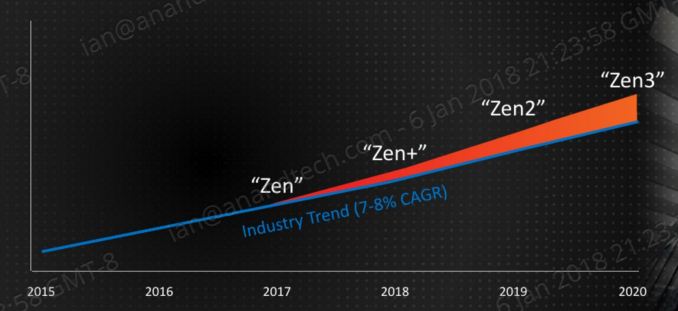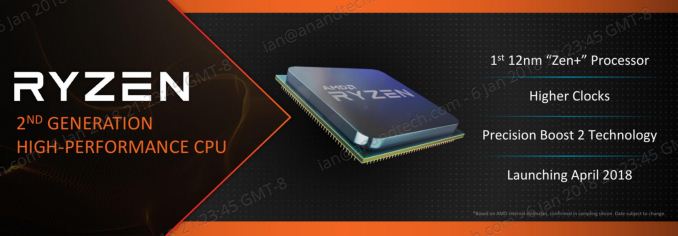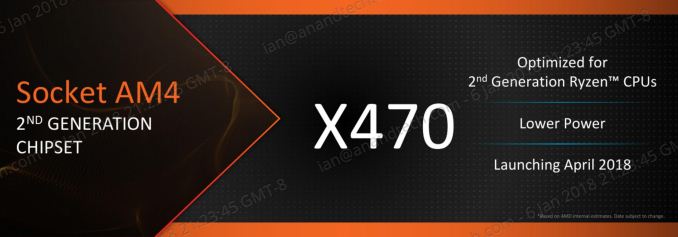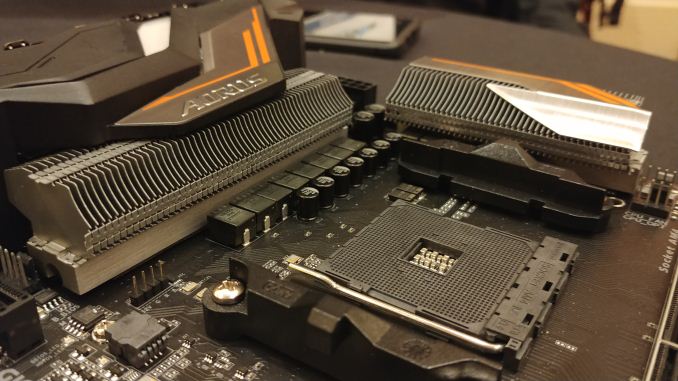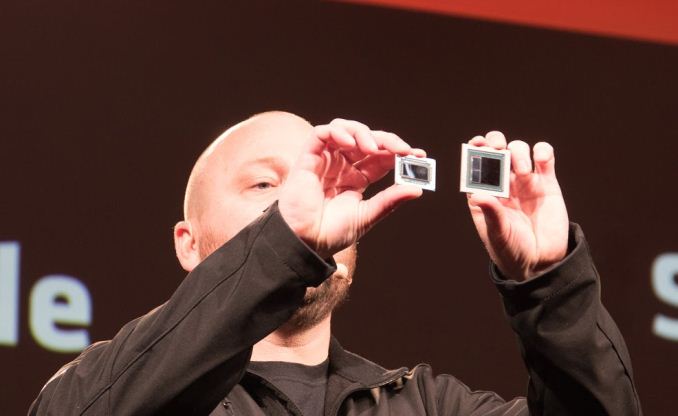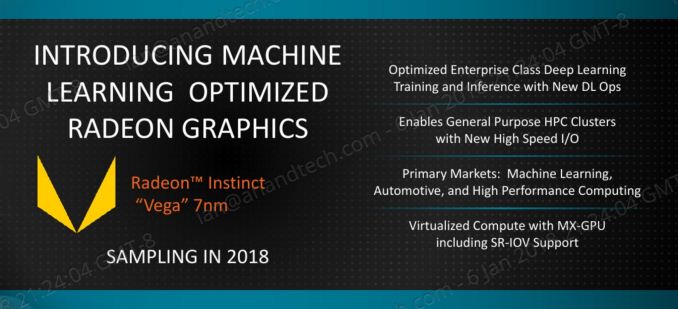
Original Link: https://www.anandtech.com/show/12233/amd-tech-day-at-ces-2018-roadmap-revealed-with-ryzen-apus-zen-on-12nm-vega-on-7nm
AMD Tech Day at CES: 2018 Roadmap Revealed, with Ryzen APUs, Zen+ on 12nm, Vega on 7nm
by Ian Cutress on February 1, 2018 8:45 AM EST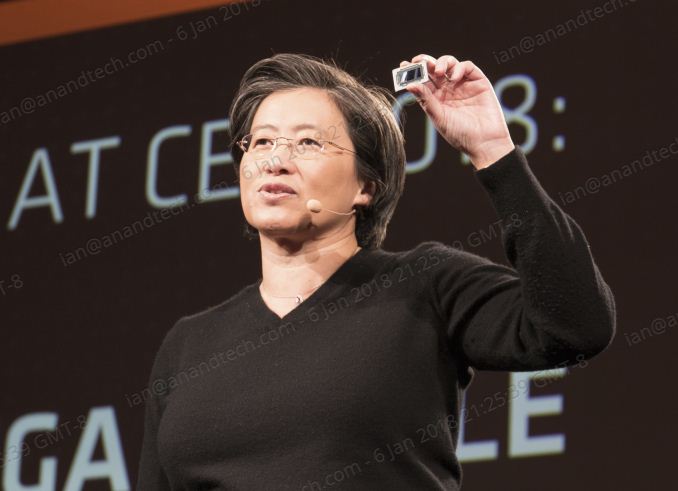
We interviewed AMD's Dr. Lisa Su at CES! You can read the interview here!
Update Feb 1st: Thank you everyone for waiting - when this was initially posted, illness stopped me writing past page two. This article has now been updated to cover the rest of AMD's announcements:
- Ryzen Mobile APUs,
- Ryzen Desktop APUs,
- APU Overclocking,
- Ryzen getting a price drop,
- The new Ryzen Wraith PRISM cooler,
- Ryzen PRO Mobile,
- FuzeDrive,
- Zen+ Cores and Second Generation Ryzen,
- GlobalFoundries 12LP,
- Vega Mobile, and
- Vega on 7nm.
To mark the start of the annual CES trade show, AMD invited the press in early to sample the latest technologies coming to its portfolio in 2018. What was quite surprising is how much AMD exposed about their plans for 2018, detailing several product lines and launch times well in advance, with some blanks to be filled in later. The highlights include Ryzen APUs, the second generation of Ryzen built on 12nm using the ‘Zen+’ microarchitecture, and proliferating Vega into as many segments as possible, including a new Vega Mobile GPU range, as well as Vega coming to GlobalFoundries’ 7nm process.
Roadmaps Are Good
To say AMD had a busy 2017 was an understatement. With 10 product family launches across CPU and GPU, it was a brave journalist that covered them all in detail. 2017 was so busy as many projects naturally culminated to that time frame, and as a result, last year was very prolific for AMD news, the AMD brand, and AMD products. 2018, by contrast, will be quieter for the frequency of noise, although as described by CTO Mark Papermaster, 2018 will be a year where AMD ramps up products and takes advantage of the low-hanging fruit for performance and product segment. CEO Dr Lisa Su stated that while AMD is a company that sometimes takes more risk than others, AMD’s goal for 2018 is to keep the focus on high-performance computing, offer more performance at every price point, and expanding customer momentum. It will be interesting to see it all play out in practice.
With this in mind, it was surprising to see AMD discuss a lot of its 2018 roadmap in the Tech Day setting. While most of the roadmap could have been predicted by those of us embedded in this industry, it was good to see AMD volunteering a lot of information. This can be a bit of a double-edged sword, if a competitor knows what you have planned, but AMD is confident that, to quote Dr Su again, ‘Ryzen was just the start’.
The first roadmap presented by AMD is the following:
This is the CPU/APU product line, and along with new product lines, there are also some new refreshes.
- Ryzen 3 Mobile APUs: January 9th
- Ryzen Desktop APUs: February 12th
- Second Generation Ryzen Desktop Processors: April.
- Ryzen Pro Mobile APUs: Q2 2018
- Second Generation Threadripper Processors: 2H 2018
- Second Generation Ryzen Pro Desktop Processors: 2H 2018
For most of these, we were given a good amount of information, which we will go into in the following pages. It is interesting to know that the second generation parts will be built on GlobalFoundries 12nm ‘12LP’ process, which we were told will offer 10%+ better performance per watt than the 14nm ‘14LPP’ process. We were also told that the new 12LP process focuses on features to optimize performance per watt, and that the new 12LP Ryzen desktop processors are already in the hands of AMD’s partners.
On the graphics side, AMD’s roadmap was a little more conservative. With the launch of Vega 56 and Vega 64 in the middle of 2017, as well as the Radeon Instinct line, AMD’s focus will be on Radeon RX Vega Mobile discrete GPUs.
These mobile-class discrete GPUs are optimized for z-height, coming in at 1.7mm, but will also use HBM2 (high bandwidth memory) on an interposer, indicating an update on AMD’s prowess on interposer technology that previously has been somewhat bulky. The purpose here for Radeon RX Vega Mobile is to move discrete graphics into mobile and small form factor systems that are currently occupied by mid-range NVIDIA graphics. HBM2 is still a premium product, so we expect that when they come to market in Q2, they will aim for thin and light systems that also want to support VR-like technologies.
Also on the list is perhaps the surprise announcement of the day: AMD will be bringing Vega to 7nm, with customer sampling expected to start in 2018. This ultimately means that Vega on 7nm will hit the shelves in 2019, but there is a twist to the tale. The first products off the line will be solely for the Radeon Instinct family and machine learning. Users who want 7nm desktop-class products will have to wait a little longer, but it does give an indication of how GlobalFoundries 7nm process is coming along.
Roadmaps to 2020
Since the announcement of AMD’s Zen core, and the subsequent detailing of the Zen microarchitecture in August 2016, the focus has ultimately been about long-term stability about AMD as a company through building the product stack after a recessive period during the Bulldozer years. AMD has set several goals out to 2020, to cover multiple generations of CPU and GPU products as well as a march on semiconductor process. The latest outlook is pretty much similar to what we have seen before.
For the x86 processor line, AMD delivered Zen based on 14nm in 2017. This covered Ryzen, Threadripper, Ryzen Pro, EPYC, and Ryzen Mobile. A revision to Zen, known as Zen+, is built on 12nm and will form the basis for AMD’s 2018 targets as listed above, including second-generation Ryzen on desktops, second-generation Threadripper for high-performance, and second generation Ryzen Pro for commercial applications. As Zen+ is a revision, it is unclear if Ryzen Mobile or EPYC will also be updated – if the roadmaps above are complete, then not in 2018. Back at the launch of EPYC, the second generation EPYC (codenamed Rome) was listed as Zen 2 on 7nm.
After Zen+ will come Zen 2, a major microarchitectural update over Zen/Zen+. While the goal of minor revisions in Zen+ is to find low hanging fruit to increase performance, Zen 2 will enable AMD to change certain paradigm concepts in the core, such as decode width, instruction support, cache behavior, and power implementations. AMD confirmed that the Zen 2 design is already complete, much to the surprise of the people in attendance. This typically means that the floorplan is fundamentally ready to go to, although minor adjustments will still need to be made as the manufacturing process is improved, optimized, and potential silicon bugs are found. In the 2018 announcements, AMD is not announcing anything Zen 2 related, so it firmly puts Zen 2 into the 2019 bucket. This also gives some indication of when GlobalFoundries expects to implement 7nm at scale.
Finally, AMD expects to implement Zen 3 by 2020. Just to be clear, if AMD did launch in Q4 of 2020 that would still be within AMD’s target window. Zen 3 will be built on an improved 7nm process called 7nm+. It is our understanding that the 12nm process is essentially a 14+ process for GloFo, so the 7+ process might be renamed at a later date perhaps. But if the Zen 2 design is complete, I would expect more of AMD’s microarchitectural engineers to be on the Zen 3 design now.
For the graphics roadmap out to 2020, the insertion of Vega at 7nm gives the following outline:
2017 saw the launch of Vega inside Radeon Instinct, Vega 64 and Vega 56, integrated into Ryzen Mobile, and a product to be sold by Intel with a Core CPU plus Vega GPU product. The beginning of 2018 will see Vega push into more APUs in mobile on the desktop, and into the discrete GPU mobile space, however no separate mainstream graphics products seem to be on the horizon. Discrete Vega chips seem to be paired only with HBM2, while combined APUs are happy with DRAM: this might be how AMD is preparing to approach its graphics stack in the future.
AMD’s GPU line will be bypassing the 12nm process used by the Zen+ CPUs, and moving straight to 7nm with Vega. This is a distinct change from previous AMD roadmaps, which had confirmed that we would be seeing Vega on a '14nm+' process node, or Vega on the 12nm process. It would appear that the '12nm' node is the new name for 14+, but AMD's GPU product line will now be bypassing this completely, despite being 'confirmed' before.
As mentioned above, AMD plans to start sampling a machine learning focused version of Vega on 7nm much later in 2018, where ‘sampling’ in this case means pre-testing to select partners. This will likely lead to a Radeon Instinct product, initially perhaps with a small die size, being made available in early 2019. The big product on 7nm, however, will be AMD’s Navi GPU architecture. AMD did not go into specific details, but we suspect that Navi will be permeating through most of AMD’s discrete product line portfolio, as well as being implemented into APUs with Zen 2 processor cores. Given the timeframe here, Navi is certainly a 2019 product, although it might be debatable if that means early or late 2019.
Before the end of 2020, AMD plans to implement its next-generation ‘post-Navi’ GPU architecture, using GlobalFoundries’ 7nm+ process. This would align with Zen 3 on the CPU side. If we took the worst case scenario that this Next-Gen design ends up in December 2020, then this gives a slight indication of how AMD would release Navi. Navi would have to be far enough away from the Next-Gen part so the Navi design could be spread across the ecosystem for AMD to reap the benefits, but also at a point where the 7nm Vega hardware would have helped optimize the 7nm process prior to Navi ramping up to full production.
Zen Cores and Vega
Ryzen 3 Mobile, Plus More Ryzen Mobile Laptops
The most immediate announcement from AMD is two Ryzen 3 Mobile processors designed to fill out the Mobile stack, and the introduction of Ryzen-based APUs for desktop machines.
At the heart of both of these designs is the combination of AMD’s first-generation Zen cores, specifically four cores in a ‘core complex’, connected to Vega-based graphics integrated into the silicon. The two units are connected via AMD’s Infinity Fabric, designed for high-bandwidth and scale, and a feature that permeates through AMD’s recent product portfolio.
Ryzen Mobile
To date, AMD has already announced two products using this configuration. Both of them are for Ryzen Mobile, specifically the Ryzen 7 2700U and Ryzen 5 2500U, which have already been pre-announced in devices such as the HP Envy x2, the Lenovo Ideapad 720S, and the Acer Swift 3. Only the HP Envy x2 has been launched into the market so far (with mixed reviews due to the OEM design, which draws similar criticisms when equipped with Intel CPUs), with the others to see light in Q1 as well as other OEMs like Dell.
The first announcement is regarding adding more Ryzen Mobile processors to the family to cater for a wider audience. To pair with the Ryzen 7 Mobile and Ryzen 5 Mobile, AMD has two Ryzen 3 Mobile parts which will formally be available on January 9th with expected system availability within Q1.
| AMD Ryzen Mobile APUs | |||||
| Ryzen 7 2700U with Vega 10 |
Ryzen 5 2500U with Vega 8 |
Ryzen 3 2300U with Vega 6 |
Ryzen 3 2200U with Vega 3 |
FX-9800P (2015) |
|
| CPU | 4C / 8T 2.2 GHz Base 3.8 GHz Turbo Zen 14nm |
4C / 8T 2.0 GHz Base 3.8 GHz Turbo Zen 14nm |
4C / 4T 2.0 GHz Base 3.4 GHz Turbo Zen 14nm |
2C / 4T 2.5 GHz Base 3.4 GHz Turbo Zen 14nm |
Dual Module 2.7 GHz Base 3.6 GHz Turbo Excavator 28nm |
| GPU | Vega 10 10 CUs 640 SPs < 1300 MHz |
Vega 8 8 CUs 512 SPs < 1100 MHz |
Vega 6 6 CUs 384 SPs |
Vega 3 3 CUs 192 SPs |
GCN 1.2 8 CUs 512 SPs > 758 MHz |
| TDP | 15W | 15W | 15 W | 15 W | 15W |
| DRAM | Up to DDR4-2400 | DDR4-1866 | |||
| L2 Cache | 512 KB/core | 1 MB/module | |||
| L3 Cache | 1 MB/core | 4 MB/core | - | ||
| PCIe Lanes | ? | ? | ? | ? | 8 x PCIe 3.0 |
| Die Size | 209.78 mm2 | 250.4 mm2 | |||
| Transistors | 4.95 billion | 3.1 billion | |||
| Launch | October 2017 | January 2018 | May 2016 | ||
The Ryzen 3 2300U is a quad-core processor without simultaneous multithreading, which separates it from the other components. The base frequency of 2.0 GHz, a top turbo of 3.4 GHz, and a total of six compute units in the Vega graphics (this equates to 384 streaming processors). The Ryzen 3 2300U shares the same TDP as the other parts, coming in at 15W, and AMD wants to position this as a high-performance part for eSports capable notebooks, handily beating anything from Intel’s 7th Generation family.
The Ryzen 3 2200U is the only dual core component in AMD’s entire Ryzen product line, although it does have simultaneous multithreading to give it four threads in total. Having two fewer cores to fire up does give it a boost on the base frequency, coming in at 2.5 GHz, but the turbo frequency matches the other Ryzen 3 at 3.4 GHz. The 2200U is certainly the processor bringing up the rear, with only three compute units (192 streaming processors) in total, and helping AMD shift some of the processors that are not binned as aggressively as the higher-performance units.
AMD is promoting these two processors as capable elements of an entry level 15W notebook that can process DirectX 12, offer advanced video features, and be used in aesthetically pleasing designs with a long battery life, including 2-in-1s, ultrathin notebooks, and gaming laptops.
New Devices
Not to be content with just announcing a couple of new Ryzen Mobile processors, AMD was eager to promote new mobile devices that will be using Ryzen Mobile. To accompany the HP Envy x360, the Lenovo Ideapad 720S, and the Acer Swift 3, Q1 will see the launch of a new HP (under embargo until later this week), the Acer Nitro 5 series, and the Dell Inspiron 5000 series.
Acer’s Nitro line of laptops is typically aimed at the gaming crowd. The Nitro 5 dictates a 15.6-inch display, which in this case is a 1920x1080 IPS panel. Acer will use the pre-announced higher-end APUs, the Ryzen 7 2700U and Ryzen 5 2500U, but will also be pairing this with a Radeon RX 560 graphics chip. We were told by AMD that the integrated graphics and discrete graphics will be used in a switching context: for video playback, the lower power integrated graphics is used and the discrete is disabled, however the discrete graphics is fired up for gaming work. For compute, or for games that support multi-adaptor DirectX 12 technologies, both the integrated graphics and the discrete graphics should be available, however this is up to the game/software to implement.
The Dell Inspiron lines are more home/small-medium business-oriented devices, and here Dell is also using the Ryzen 7 2700U and Ryzen 5 2500U processors to offer peak Mobile APU performance. Designed more as a workhorse than for aesthetics, the Inspiron 5000 will offer AMD parts with 15.6-inch and 17-inch displays in a chassis that can support dual HDD/SSD options. The unit also comes with an optional Radeon 530 discrete GPU, which has 384 compute units based on AMD’s older GCN 1.0 architecture. This comes across as very odd, given that even the Ryzen 5 has 512 compute units of the newer Vega architecture. I can only assume that this provides extra displays for very specific customers, though for most it would seem an overly pointless addition.
Zen Cores and Vega: Ryzen APUs for AM4
It has always been expected that AMD would launch processors with integrated graphics on the main AM4 desktop platform. With over 120+ AM4 motherboards in the market, most of them with display outputs , the launch of APUs beyond the units based on the last generation CPU microarchitecture would normally have been alongside the original Ryzen launch, however AMD felt that a focus on the silicon for mobile platforms first was part of the corporate strategy. Nonetheless, AMD is aiming their Ryzen APUs at consumers to replace a Core i5 and low end GPU setup.
APUs from $99
Unlike other Ryzen launches, AMD is starting with the low and mid-range processor versions first. This comes in the form of the Ryzen 5 2400G and the Ryzen 3 2200G, where ‘G’ is using for graphics. If that reminds you of a series of processors that was recently released by Intel, then it is either a case of Intel and AMD working on this naming strategy, or sheer luck that both of them is using the same designation.
| AMD Ryzen 2000-Series APUs | ||
| Ryzen 5 2400G with Vega 11 |
Ryzen 3 2200G with Vega 8 |
|
| CPU Cores/Threads | 4 / 8 | 4 / 4 |
| Base CPU Frequency | 3.6 GHz | 3.5 GHz |
| Turbo CPU Frequency | 3.9 GHz | 3.7 GHz |
| TDP @ Base Frequency | 65 W | 65 W |
| Configurable TDP | 46-65 W | 46-65 W |
| L2 Cache | 512 KB/core | 512 KB/core |
| L3 Cache | 4 MB | 4 MB |
| Graphics | Vega 11 | Vega 8 |
| Compute Units | 11 CUs | 8 CUs |
| Streaming Processors | 704 SPs | 512 SPs |
| Base GPU Frequency | 1250 MHz | 1100 MHz |
| DRAM Support | DDR4-2933 Dual Channel |
DDR4-2933 Dual Channel |
| OPN PIB | YD2400C4FBBOX | YD2200C5FBBOX |
| OPN Tray | YD2400C5M4MFB | YD2200C4M4MFB |
| Price | $169 | $99 |
| Bundled Cooler | AMD Wraith Stealth | AMD Wraith Stealth |
Despite the Ryzen 5 2400G being classified as a ‘Ryzen 5’, the specifications of the chip are pretty much the peak specifications that the silicon is expected to offer. AMD has stated that at this time no Ryzen 7 equivalent is planned. The Ryzen 5 2400G has a full complement of four cores with simultaneous multi-threading, and a full set of 11 compute units on the integrated graphics. This is one higher than the Ryzen 7 Mobile processor, which only has 10 compute units. This translates as 704 streaming processors, compared to 640 SPs. Aside from the full set of hardware, the CPU frequency is very high, similar to the standard Ryzen 7 desktop processors: a base frequency of 3.6 GHz and a turbo of 3.9 GHz will leave little room for overclocking. Yes, these chips are overclockable. The integrated graphics frequency will default to 1250 MHz and the total chip TDP is 65W. Maximum supported memory frequency will vary depending on how much memory is used and what type, but AMD lists DDR4-2933 as the support for one single-sided module per channel.
A side bit of news on the Ryzen 5 2400G is that it somewhat replaces the Ryzen 5 1400 at the $169 price point. Both chips will continue to be sold, but at this price point AMD will be promoting the 2400G over the 1400.
The cheaper $99 processor is the Ryzen 3 2200G. The specifications follow the other Ryzen 3 processors already in the market: four cores, and no simultaneous multi-threading. The rated frequencies, 3.5 GHz for base and 3.7 GHz for turbo, are slightly below that of the Ryzen 5 2400G but are still reasonably high – despite this chip being rated for 65W, the same as the Ryzen 5 2400G, users might expect this processor to turbo for longer within its power window as long as it is within its thermal boundaries. The suggested retail price of $99 means that this is the cheapest Ryzen desktop processor on the market, and it crosses a fantastic line for consumers, with four high-performance x86 cores under the $100 retail line. The integrated graphics provide 512 streaming processors, identical to the $169 processors from previous generations, but this time upgraded with the Vega architecture.
Within the presentations at Tech Day, AMD typically provides plenty of performance data from their own labs. Of course, we prefer to present our own data obtained in our labs, but combing through AMD’s numbers provided a poignant point as to just how confident AMD is on even its low end unit: using the 3DMark 11 Performance benchmark, the Ryzen 3 2200G (according to AMD) scored 3366 points, while on the same benchmark Intel’s best integrated graphics offering, the Core i7-5775C with embedded DRAM, scored only 3094. If we took this data point as the be-all and end-all, it would come across that AMD has broken Intel’s integrated graphics strategy.
One of the other important elements to the Ryzen APU launch is that both processors, including the Ryzen 3 2200G for $99, will be bundled with AMD’s revamped Wraith Stealth (non-RGB) 65W cooler. This isn’t the high-end AMD cooler, but as far as stock coolers go, it easily introduces a $30 saving to any PC build, reducing the need to buy a hefty standard cooler.
AMD vs. Intel
AMD’s main target with these new processors is to offer something Intel cannot: a combined processor and graphics package. Much like a number of AMD’s previous generation of products, the focus is two-fold: offering more performance at the same price, or being cheaper at equal performance.
For the first part of that argument, about having more performance at the same price, AMD suggests the following competition for the Ryzen 5 2400G:
- $169 Ryzen 5 2400G (4C/8T, 3.6 GHz, 704 SPs)
- $182 Core i5-7400 (4C/4T, 3.0 GHz, 24 EUs)
- $187 Core i5-8400 (6C/6T, 2.8 GHz, 24 EUs)
AMD cites that in its internal testing, the 2400G scores 20% higher than the i5-8400 on PCMark 10, and can post 1920x1080 gaming results above 49 FPS in titles such as Battlefield One, Overwatch, Rocket League, and Skyrim, having 2x to 3x higher framerates than Intel’s integrated graphics.
For the Ryzen 3 2200G, the competing products are less well defined:
- $99 Ryzen 3 2200G (4C/4T, 3.5 GHz, 512 SPs)
- $117 Core i3-8100 (4C/4T, 3.6 GHz, 23 EUs)
- $84 Pentium G4620 (2C/4T, 3.7 GHz, 12 EUs)
Again, through its internal testing, AMD is stating that the 2200G scores 13% higher than the Core i3-8100 in PCMark 10, as well as being within a few frames of the Ryzen 3 2400G in titles such as Rocket League, Skyrim, and Battlefield One.
The other side of the argument is price for the same performance. For this comparison, AMD suggests to test the new APUs against Intel processors paired with NVIDIA graphics, specifically the GT 1030. AMD’s data suggests that a Core i5-8400 with a GT1030 scores the same as a Ryzen 5 2400G in the 3DMark TimeSpy benchmark, although costing $290 (vs $169 for the APU) and drawing 30W more power.
Both of these APUs will be introduced to the market on February 12, which is when the review NDA also lifts for the media. We have a number of the required Intel processors to test against, and we also ordered a GT 1030 for additional testing points, however the retailer sent me an LED kit by mistake. Hopefully it can get switched around with enough time for testing.
AMD vs. AMD: Raven Ridge and Bristol Ridge
These two new APUs have the internal codename of ‘Raven Ridge’ to signify the family of products. AMD also has ‘Bristol Ridge’ already in the market, using the previous generation of CPU cores and previous generation of integrated graphics. AMD has not actively promoted Bristol Ridge to the public in any serious way, with these parts being hold-overs from the previous platform and designed to be a quick fill within AMD’s product line. To that effect, Bristol Ridge processors were only available for OEMs at the beginning for pre-built systems, and AMD only made them available to the public within the last few months. To our knowledge, AMD did not initiate a review sampling program to the press of these processors either.
With the launch of the two new Zen-plus-Vega Raven Ridge APUs, the Bristol Ridge processors will still continue to be sold. AMD’s reasoning revolves around offering choice in the market, particularly to its OEM customers, and has stated that the two products offer different features and is thus not competing on price. It is clear to say that for anyone buying a new system, the newest products offer the better value: a much higher per-core performance, improved thermal budgeting, newer integrated graphics, and ultimately the core design is the future of AMD. The only items that Bristol Ridge brings to the table now are the legacy aspect, to replace like-for-like, and the offer of a number of 35W-rated products. Bristol Ridge PRO processors are also on the market, offered alongside the new Ryzen PRO with Vega (more on this later).
Squaring up the competing parts shows that:
| Raven Ridge vs. Bristol Ridge | |||||
| Ryzen 5 2400G |
A12-9800 | Ryzen 3 2200G |
A10-9700 | ||
| Core uArch | Zen | Excavator | Zen | Excavator | |
| Cores/Threads | 4 / 8 | 2 / 4 | 4 / 4 | 2 / 4 | |
| Base CPU Frequency | 3.6 GHz | 3.8 GHz | 3.5 GHz | 3.5 GHz | |
| Turbo CPU Frequency | 3.9 GHz | 4.2 GHz | 3.7 GHz | 3.8 GHz | |
| TDP | 65 W | 65 W | 65 W | 65 W | |
| cTDP | 46-65 W | 45-65W | 46-65 W | 45-65W | |
| L2 Cache | 512 KB/core | 1 MB/core | 512 KB/core | 1 MB/core | |
| L3 Cache | 4 MB | - | 4 MB | - | |
| Graphics | Vega 11 | GCN 3 Gen | Vega 8 | GCN 3 Gen | |
| Compute Units | 11 CUs | 8 CUs | 8 CUs | 6 CUs | |
| Streaming Processors | 704 SPs | 512 SPs | 512 SPs | 384 SPs | |
| Base GPU Frequency | 1250 MHz | 1108 MHz | 1100 MHz | 1029 MHz | |
| DRAM Support | DDR4-2933 | DDR4-2400 | DDR4-2933 | DDR4-2400 | |
| Price | $169 | $99 | $99 | $79 | |
Given the performance uplift we have seen from previous generation A-series processors to the Ryzen desktop parts already, the new APUs should put the nail in the coffin for older AMD parts.
Ryzen APU Overclocking: A Focus on Memory Support
Also part of the demonstration about the new APUs was overclocking. For a number of years, AMD has hired Sami Makkinen, a well-known former world-record holder in various overclocking categories, to help tune the overclocking on some of its processors. So despite this being an integrated graphics platform, Sami was on hand to show the day-to-day overclocking potential. I was told that liquid nitrogen overclocking might be held at a later date…
Nonetheless, we were shown the system that would be distributed to reviewers for launch day: a mini-ITX motherboard, a Ryzen 5 2400G processor, 2x8 GB of DDR4 memory, and an AMD Wraith cooler. Using the popular benchmarking tool 3DMark Fire Strike, Sami showed a 39% increase over stock performance by overclocking only the memory and the integrated graphics:
- DDR4-2400 + 1250 MHz GPU: 2911 Points - 'stock'
- DDR4-3200 + 1250 MHz GPU: 3322 Points (+14%)
- DDR4-3200 + 1550 MHz GPU: 3596 Points (+24%)
- DDR4-3600 + 1675 MHz GPU: 4048 Points (+39%)
This shows a couple of interesting data points. First, that the DRAM speed directly influences the results a lot: the 14% gain moving to DDR4-3200 and a similar gain again up to DDR-3600 means that we are still dealing with a graphics system that is memory bandwidth limited, even with only 11 compute units. The Infinity Fabric communication pathways are tied to the DRAM speed, so these would also get a speed up – when asked if it would be possible to discern how much of the speedup is due to a pure DRAM improvement and how much from the Infinity Fabric boost, I was told that AMD could do it in house, but it would be impossible for consumers to do.
However, the DRAM speed gains match up with what we have seen with previous generations of AMD APUs, but also it means that Intel’s decision to combine a Vega GPU with high-bandwidth memory is going to be the way forward in this market.
The second point that this data brings is about memory support. One of the major criticisms of AMD’s initial launch of Ryzen was the lack of high-performance memory support, due to a young firmware. AMD has stated that the Ryzen with Vega graphics line of processors have better memory support with newer firmware revisions, capable of driving higher memory speeds. This is, of course, important to APUs. Additional updates will be coming with the new X470 motherboards in Q2.
AMD Ryzen Price Drops, New Wraith Prism
One of the elements we reported on almost immediately was AMD’s decision to drop the suggested retail pricing of its current Ryzen desktop processors. Since the launch last year, Ryzen processors have varied quite dramatically from then to now: the processors started off at the launch pricing, but through the summer and into the winter, many retailers were offering discounts, without any catches. Throughout this time, AMD maintained that their launch-day pricing structure was still in place, and it was up to distributors and retailers to dictate the exact pricing, and as far as AMD was concerned, the price at which these processors were sold to distributors had not changed. This did not stop some of the media from speculating wildly in spite of AMD’s official line.
So fast forward to CES 2018, and the first official price list change for Ryzen really does shake up the landscape. For the top mainstream processors, there are deep discounts to be had, with up to $150 coming off the price of the Ryzen 7 1800X. The full list is as follows:
| AMD Ryzen New Pricing | |||||
| Processor | Socket | Type | Cores/Threads | Old SEP | New SEP |
| Ryzen TR 1950X | TR4 | HEDT | 16 / 32 | $999 | No Change |
| Ryzen TR 1920X | TR4 | HEDT | 12 / 24 | $799 | No Change |
| Ryzen TR 1900X | TR4 | HEDT | 8 / 16 | $549 | $449 |
| Ryzen 7 1800X | AM4 | CPU | 8 / 16 | $499 | $349 |
| Ryzen 7 1700X | AM4 | CPU | 8 / 16 | $399 | $309 |
| Ryzen 7 1700 | AM4 | CPU | 8 / 16 | $329 | $299 |
| Ryzen 5 1600X | AM4 | CPU | 6 / 12 | $249 | $219 |
| Ryzen 5 1600 | AM4 | CPU | 6 / 12 | $219 | $189 |
| Ryzen 5 1500X | AM4 | CPU | 4 / 8 | $189 | $174 |
| Ryzen 5 1400 | AM4 | CPU | 4 / 8 | $169 | No Change |
| Ryzen 5 2400G | AM4 | APU | 4 / 8 | N/A | $169 |
| Ryzen 3 1300X | AM4 | CPU | 4 / 4 | $129 | No Change |
| Ryzen 3 1200 | AM4 | CPU | 4 / 4 | $109 | No Change |
| Ryzen 3 2200G | AM4 | APU | 4 / 4 | N/A | $99 |
If we line up a direct AMD vs. Intel with this new pricing, it is clear that there are a couple of battle grounds. The Ryzen 7 1800X, now at $349, squares up with the Core i7-7700K at $350, the previous generation high-end overclockable processor. The Ryzen 7 1700, our suggested mainstream AMD processor in 2017 is now $299, undercutting the Core i7-8700 while still having more cores. The Ryzen 5 1600 at $190 is now aligned with the Core i5-8400 at $187, and for this price the Ryzen 5 1600 offers simultaneous multi-threading whereas the Intel processor does not.
Down at the low end are the new processors with Vega graphics, the Ryzen 5 2400G at $169 and the Ryzen 3 2200U at $99, which are priced against the Core i5-8400 at $187 and Core i3-8100 at $117 respectively.
To put this into perspective, Intel used to publish its price list weekly, but after accidentally leaking the details of processors before launch, have migrated it to monthly (though they seem to have missed January?). Nonetheless, Intel rarely changes the suggested retail pricing of its mainstream processors.
What is not mentioned in this table is which processors come with which coolers. AMD’s best-selling products come with variants of the Wraith cooler provided in box, which would be considered a separate cost on the Intel lineup.
Wraith PRISM Launched, Wraith Max Reduced
As part of the price drop announcement, AMD is introducing a new variant of their Wraith cooler family to system integrators. The Wraith PRISM will sit above the Wraith Max and Wraith Spire in the family, going above the Max with a rainbow LED ring instead of just a red one, and illuminated fan blades. AMD is citing enhanced motherboard compatibility for the LEDs, and it still uses the same mounting mechanism since AM2. There will be an overclockable fan profile, or a silent operation mode capable of 39 decibels.
The only ‘downside’ to the cooler is that it will not be on general sale, or be bundled with any processors. In order to get one, it will be up to system integrators to use it and for users to buy a pre-built system. As a result, the cost will be up to the system integrator.
Edit Feb 2nd: Apologies on my part, this paragraph is wrong. I had erroneously remembered what AMD had told us. It has since been clarified: AMD will be communicating its Wraith PRISM strategy later through Q1.
The other element on cooler updates is a price drop for the Wraith Max. This is the one Wraith cooler that AMD does actually sell at retail, representing a 125W near-silent cooler with a shroud and a red LED ring around the fan. When AMD launched the cooler for $60 last year, a few of us baulked at the price: it’s a nice cooler to have, but it is not a $60 value. AMD is now going to have a suggested retail price of $45, which is more nearer the mark, but the cooler market is a competitive place for this sort of thing.
Zen and Vega: Ryzen PRO Mobile
In the second half of last year, AMD’s Enterprise, Embedded and Semi-Custom division (now the Enterprise and Embedded division) launched its Ryzen PRO family of desktop processors, for business customers that needed additional management capabilities. AMD has been making ‘Pro’ versions of its consumer processors for several generations now, usually mimicking the specifications of the consumer products aside from the management support.
These products, by and large, go up against Intel’s equivalent vPro processors, and AMD’s value add revolves around support for DASH, an open-source management protocol, TSME (transparent secure memory encryption), and its commitment to customer requests such as operating system image stability (18-months), guaranteed processor availability (24-months), manufacturing specifications designed for long-term reliability, and a commercial limited warranty (36-months). AMD also likes to tout that it offers a Pro product at the lower end of the market, where Intel does not have a vPro-enabled Core i3.
As part of the AMD Tech Day, it was announced that the Ryzen PRO Mobile family will be launched in Spring 2018. These components are, by and large, the Ryzen Mobile family of processors with Vega graphics but with the added Pro features listed above. For performance and power, AMD states similar sorts of numbers as it did with the launch of Ryzen Mobile: up to 270% better performance per watt, targeting 13 hours of useful battery life, 9 hours of HD video playback, and targeting a generation of sleek and powerful laptops, in this case focused for the Enterprise market.
So much like the Ryzen 7 2700U, the Ryzen 5 2500U, and the Ryzen 3 2300U, AMD will launch the Ryzen PRO Mobile equivalents:
We are likely to see OEMs that currently provide AMD A-Series PRO notebooks to offer updated versions with these new processors, as well as a series of new designs coming into the business and enterprise market.
Over the years we have seen various attempts from AMD and Intel to try and help improve storage performance on their mainstream platforms. Because of the solid user experience benefits that solid state storage can bring, these attempts come in two forms: to make the most of a small amount of super-fast storage, or to expand the amount of super-fast storage available. Most attempts at this have been laborious, such as Intel’s caching technology that allows a SSD or 32GB of Optane Memory to act as a quick read/write cache for a rotational drive.
AMD’s latest attempt to boost the storage performance is Enmotus FuzeDrive, a collaborative piece of software that is designed to combine several storage devices into one big disk. The principle is fairly simple: take any combination of rotational hard drive, SATA SSD, NVMe SSD, and even DRAM, and this software will create a single drive that addresses them all. The software and drivers will manage what data goes where for quicker access, rather than it appearing as one big JBOD.
The obvious red flags from the press were about DRAM, which we were told will only act as a read-cache from prepared data taken from the other drives. The other flag was about if one drive in that system fails, whether all the data is lost. The answer was a likely yes, and so the risk of such a system might be in-line with a JBOD array or similar to a RAID-0, but without the predictable speedup a RAID-0 array might bring.
Predictive caching technologies to help speed up read/write access times are, on paper, a good idea. Some SSDs already do this, by having a small amount of fast SLC cache to act as a write buffer, which the controller can then move the data around to empty the cache when the drive is idle. The difference between having something like a controller manage an embedded system and a general software package in play is that the embedded system has to work for a single drive, albeit millions of units. That arrangement is going to be as defined and engineered as much as that SSD vendor wants it to be. For a software package, it has to work across a variety of environments that might be badly configured, or in situations that the software might not be able to identify properly. As the software stretches over three or four different drives, it sounds like a potential failure in the making of one of those drives decides to die.
AMD lists several benefits of FuzeDrive: no Windows reinstall required, drives can be added to the pool at any point, or removed from the pool if sufficient spare space exists. Pools with DRAM added can be configured manually if some more DRAM is needed. AMD lists that in its testing, comparing a 500 GB hard-drive to a system with a Samsung 960 Pro added to the pool, they recorded a 578% faster Adobe Premiere launch, and a 931% faster Adobe Photoshop launch.
I could see FuzeDrive being useful in two particular scenarios: If a user as a small (32-128 GB) NVMe drive and a 1TB SSD/HDD, a single pool can be made. Users with a single large drive (SATA or HDD) could use the software to add DRAM, enabling an automatic RAM disk.
Enmotus FuzeDrive will be available for Ryzen Desktop systems, and will cost $20.
2nd Generation Ryzen
AMD has always stated that its Zen core design will form the basis of its high-performance x86 processors for the foreseeable future. This has included, among other things, a cadence with releasing updates and new Zen-like processor designs into the market. As announced at Tech Day, the update to 1st Generation Ryzen will be 2nd Generation Ryzen, coming in April 2018.
Specific core counts, frequencies, or model numbers were not mentioned – we are still 2-3 months away from this launch. AMD did state a number of points worth discussing however, especially with its decision to use GlobalFoundries newest 12nm ‘LP’ design process (12LP), compared to the 14nm ‘LPP’ design process (14LPP) used in the first generation Ryzen products.
First I want to go to this graph, to show what AMD want to claim on raw performance over the next three years:
This is a graph of raw performance, combining both the efficiency of processing instructions (IPC, instructions per clock) as well as benefits from an improved manufacturing process. AMD cites the industry trend as growing 7-8% every year, and that they fully expect the Zen package, due to design improvements in the microarchitecture and better foundry notes, will go above and beyond that 7-8% figure.
So first up along that line is Zen+. This will be the name of the core in the 2nd Generation Ryzen family, built on GlobalFoundries 12LP process. AMD has categorically stated that the core microarchitecture underneath has not changed: we will still have the same front-end and back-end as Zen, with the same size caches and the same layout. What has changed will be some of the power management algorithms, and perhaps some tweaks to the neural network-based prefetch algorithms. This will be headlined as ‘Precision Boost 2’ support, which is a feature that has already been introduced to the Ryzen with Vega graphics components (desktop and mobile).
GlobalFoundries 12LP
Most of the physical changes happen due to the process. Last year, AMD cited that its second generation Ryzen products will be on a ‘14+’ manufacturing node, but now it is going to be on a 12LP process. Some people argue that this is a clever marketing ploy as a name change, given nothing in the designs actually comes close to 14nm or 12nm. We were told that 12LP implements stricter design rules for the manufacturing process, requiring changes to library layout and the floorplan, but with an end result of a focus on performance per watt.
For the new processors, AMD is claiming a 10% boost in performance per watt overall. This is going to be taken as higher clocks for the same power at the high-end and lower power for the same frequency for more power sensitive products. AMD’s slide from Jim Anderson’s presentation above specifically says ‘higher clocks’, which when combined with Mark Papermaster’s presentation which states ‘10%+ performance vs. 14LPP’, we could take this to mean that we should expect anywhere from an 8%+ increase in frequencies with 2nd Generation Ryzen for desktop (not 10%, accounting for the fact that the power/efficiency curve gets worse the faster you are).
| Comparison of 14 nm Branded Process Technologies | |||||||
| GlobalFoundries 12LP |
GlobalFoundries 14HP |
GlobalFoundries 14LPP ? |
TSMC 16FF |
Intel 14nm |
|||
| Fin Pitch | ? | ? | ? | ? | 42 nm | ||
| Gate Pitch | ? | ? | 78 nm | 90 nm | 70 nm | ||
| Min Metal Pitch | ? | ? | 64 nm | 64 nm | 52 nm | ||
| Gate Height | ? | ? | less than 480 nm | 480 nm | 399 nm | ||
| Metal Layers | 13 | 17 | 13 | unknown | unknown | ||
| Design Library | 7.5T | 12T | 9T | 9T | unknown | ||
The 10% figure is corroborated by GlobalFoundries, who back in 2017 stated that its 12LP process will offer a 10% better performance. GF also stated that the 12LP process also offers a 15% area reduction against 14LPP. This is done, according to GlobalFoundries, by using 7.5T libraries rather than 9T libraries. This requires its customers to ‘recompile’ their 14LPP designs for the adjusted 12LP process.
To put this into context, this means we might see 4.3-4.5 GHz processors with the 2nd Generation Ryzen sticker where we used to see 4.0 GHz processors. It will be interesting to see how AMD and GlobalFoundries have moved that seemingly hard overclock limit we saw on processors like the Ryzen 7 1800X, which had a hard time moving past 4.2 GHz on all cores.
We are having a tour around GlobalFoundries Fab 8 in New York this week, and are set to spend some time with CTO Gary Patton, talking about the new process. While he is unlikely to quote specifically about how AMD has used the new design rules to its advantage, he might tell us some more information about the process in general.
As for 2nd Generation Ryzen, we are told that the major motherboard vendors and OEMs already have near-final engineering samples to hand to ensure updated compatibility.
New Motherboards: X470 Chipset and AM4 Motherboards
Launching around the same time as the new processors will be a range of X470 motherboards from the main motherboard manufacturers. Strictly speaking, these motherboards are not needed: the current AM4 motherboards based on the X370/B350/A320 chipsets on the market will accept the new processors (as well as APUs) with a relevant BIOS update. However, AMD plans to optimize its high-end chipset with a few new features.
What we know so far is that the new X470 chipset is designed for lower power. How that is achieved, AMD would not go into at this point, however the fact that the X370 chipset was an outsourced product through ASMedia built on TSMC’s 55nm process would point to at least one way AMD could save power: building it on TSMC’s 40nm process for a start. We are told that the X370 and X470 chipsets are pin-compatible, which is not a limit to this theory, but an interesting point nonetheless.
AMD has stated that the new chipsets will be optimized better for the newer processors, which can be translated as better memory support and a few newer features. We were told that X470 will have very specific new features, although AMD did not want to disclose anything until we get closer to the launch.
We were lucky enough to see a GIGABYTE based X470 motherboard at CES.
You can read our analysis on this motherboard here.
Second Generation Threadripper
In the second half of 2018, AMD will launch a second generation of Threadripper, based on the new 12LP process. AMD did not go into specific details here, mainly because the launch is so far away, but users should look forward to the same improvements as the standard Ryzen products: up to 10% better raw performance due to the improved manufacturing process, Precision Boost 2 support, and better memory compatibility.
We are not expecting anything to change on core counts or other features like PCIe lanes.
Vega in 2018
One of the more disappointing elements to the roadmap announcements at AMD’s Tech Day was about graphics, and specifically Vega. To put it bluntly, there are no updates from AMD coming to the consumer desktop graphics market in 2018. With everything going on regarding the cycle of GPU architectures, and the insatiable demand for AMD graphics cards from cryptocurrency miners driving prices sky-high, the enthusiast and high-end gamers are getting the thin-end of the wedge.
Unfortunately, AMD is getting the blame for this, with many gamers blindly demanding ‘why not make more?’. In a recent earnings call, AMD CEO Lisa Su that they are making as many Vega graphics processors as possible, and also increasing their order with the fabs to produce more. Dr. Su put the problems with production squarely in the hands of the DRAM manufacturers, stating that memory supplies (GDDR5 and HBM2) are not sufficient to meet the high demand from everyone that needs them, which is also driving up cost. As a result, AMD isn’t blaming itself for the lack of GPUs being made available to consumers, but is saying that Samsung, Micron, and SK Hynix are not producing enough. AMD seem to be selling as many GPUs as they can make, which is good for their balance sheet at least.
So while there is nothing to look forward to on the desktop graphics side, AMD did mark on its roadmap two specific graphics products for 2018.
Vega Mobile, with HBM2
The graphics strategy in notebooks is bifurcated for AMD. On one side, their Mobile APU business takes care of the low-end of the market. The recent business relationship with Intel to sell graphics chips for Intel’s high-end mobile processors means AMD has a business on that side. The big hole in the middle is for notebook customers that want discrete graphics. After a couple of years of large Polaris based designs using GDDR, AMD is bringing Vega to this market.
As far as AMD were prepared to announce, a single Vega Mobile design is being prepared, which might be subject to binning based on compute units. The full amount of compute units in the chip has not been made publicly available, however it measures basically half of the full Vega 64 chip next to it. This would normally suggest a 32 CU chip, however there are a number of front-end elements required which have a fixed size – compared to the Intel 24 CU chip for the Intel with Radeon Graphics processor, this chip seems to be of similar size, if not bigger.
What we do know about the Vega Mobile processor is that it is paired with 4GB of HBM2, using an embedded interposer to give an overall z-height of 1.7mm. This is AMD’s second or third generation of interposer technology, and it has come a long way since Fiji: the interposer is tight along the dimensions of the GPU and HBM, but it is also embedded into the PCB. The embedding allows it to reduce the height, making it a better fit for ‘thin and light’ mobile platforms. The interesting correlation here is that at 1.7mm, it matches Intel’s EMIB implementation which is also 1.7mm. This caused two theories: either AMD is using EMIB (it isn’t), or it means that the perceived z-height benefit from using EMIB might not exist. The latter is true: AMD has unequivocally confirmed that it is using an interposer, and does not have access to Intel’s EMIB.
Ultimately AMD created more questions and answers with this announcement. Nothing was said regarding power, price, expected CPU/GPU combinations, or which notebook partners they have ready to use it. The only element to the discussion was that the chip will enable VR-capable notebooks, support HDMI 2.1 variable refresh rates, and will be coming in 2018. (Not to be all Maudlin, but watch out for the GPU manufacturer that puts three on a graphics card and sells it to miners.)
AMD Sampling 7nm Vega in Q4 2018
In previous roadmaps, AMD stated that it would be using a 14+/12nm process node for an update to its Vega design. At the Tech Day, that part of the roadmap no longer existed, and in its place was the announcement of a 7nm Vega graphics processor to be sampled at the end of the year.
This announcement came with a lot of questions, specifically whether 7nm would be ready for Q4 2018. AMD clarified its remarks by saying that this product will not be aimed at gamers, but will be a version of Vega specifically for machine learning, and they expect only to be sampling select customers with early silicon at the time.
This slide above lays most of it out: the design will be an optimized version of Vega, which means it might not look much like a Vega GPU as we know it. AMD is planning that this product is used both for training and inference, with a focus on new deep learning operations – specifically aimed at HPC clusters. AMD also cites a new high-speed IO in play, which might be a version of Infinity Fabric designed to compete with NVLink, as well as virtualization support.
With 7nm in its infancy, we highly expect it to be a small bit of silicon, something akin to the current Radeon Instinct MI8. By using small silicon in a high margin market, this will allow AMD to optimize the design plans for its other 7nm products. This is what Ryan called a ‘pipe-cleaner’ processor, and it makes sense for semiconductor fabs to focus on smaller processors to start with, as these will yield at higher rates.
With a planned sampling in Q4 2018, we might expect volume production to be nearer Q2 2019. This means that the next generation of consumer-focused graphics, perhaps using the newer Navi architecture, will be in the mid-2019 timeframe. According to AMD’s roadmaps, it is committed to demonstrating Vega on 7nm, Navi on 7nm, and a ‘next-gen’ design on 7+ before the end of 2020. Obviously there was no clarification on whether that final design is consumer or enterprise focused for 2020. In our recent interview with AMD’s CEO, when asked if the GPU market will at some point have to bifurcate between gaming focused and compute focused designs, Dr. Lisa Su stated that ‘it must be the case’.
Updates on AMD and RTG
At the time of the event, AMD was in technical limbo, with former Radeon Technology Group leader Raja Koduri leaving for Intel. Since the event (i.e. between the event and the time this is published), AMD has reimagined the role and hired two people to fill it: Mike Rayfield will head up the business side of RTG, while David Yang, who used to work for AMD on GPUs, is rehired to take control of the technology side of RTG.
You can read our analysis of these hirings here.

